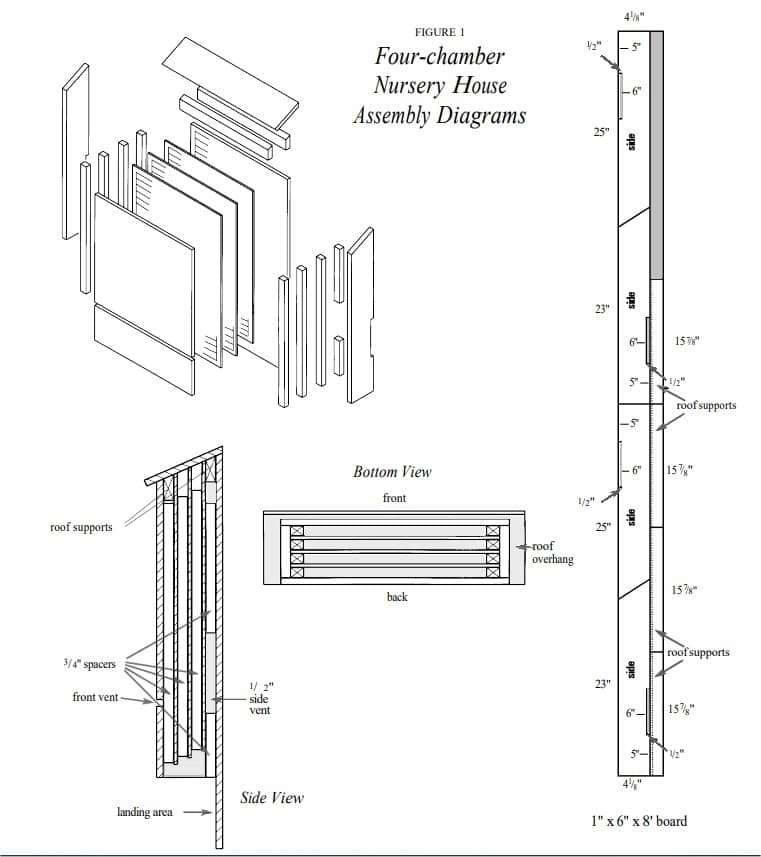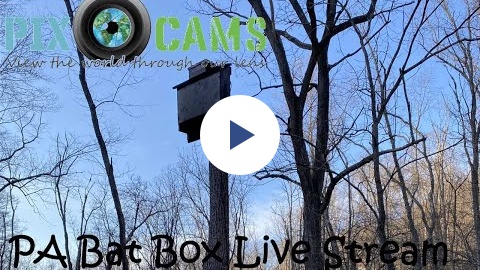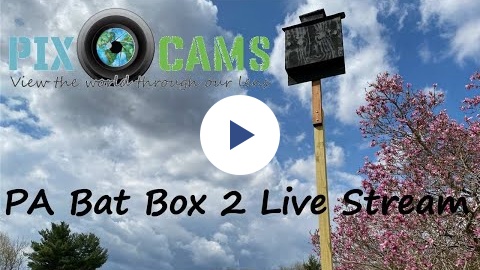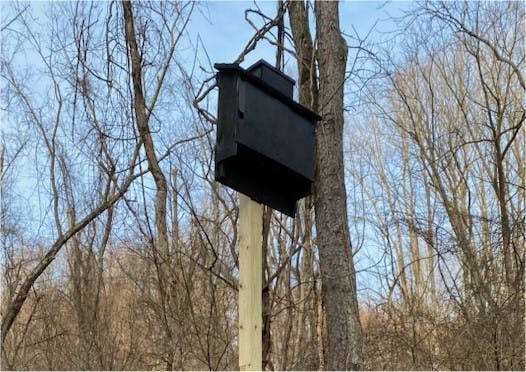Consider Installing a Bat Box
Bats are the only mammals that fly. Their wings are thin membranes of skin stretched from fore to hind legs, and from hind legs to tail. The name of their order, Chiroptera, means “hand-winged.” Their long, slender finger bones act as wing struts, stretching the skin taut for flying; closed, they fold the wings alongside the body.
In Pennsylvania where PixCams, Inc. is located, bats play a crucial role in the state’s ecosystem as insectivores, particularly aiding in controlling populations of nocturnal insects. The Commonwealth is home to a variety of bat species, including the little brown bat (Myotis lucifugus), big brown bat (Eptesicus fuscus), and the eastern red bat (Lasiurus borealis). However, Pennsylvania, like many regions globally, has experienced declines in bat populations due to factors such as habitat loss, disease (like white-nose syndrome), and pesticide exposure. Conservation efforts have been implemented to address these threats and protect bat populations. The state’s diverse landscapes, encompassing forests, urban areas, and rural regions, provide various habitats for bats to roost and forage. Residents often install bat boxes to support these beneficial creatures, as they contribute to natural pest control and overall biodiversity in Pennsylvania’s ecosystems.
 Bat Box Installed by PixCams in Southwestern Pennsylvania Bat Box Installed by PixCams in Southwestern Pennsylvania |

This video shows a bat caught on the PixCams Migration Camera on 2/21/2024.
Here are a few reasons why you should consider installing a bat box this spring:
1. Natural Insect Control
Bats are voracious insect-eaters, and having them around can help control populations of mosquitoes and other pests naturally. This can contribute to a reduction in the need for chemical insecticides.
Bats are exceptional natural insect control species, playing a vital role in maintaining ecological balance. Renowned as voracious insectivores, bats are especially adept at hunting and consuming vast numbers of nocturnal insects, including moths, beetles, and mosquitoes. A single bat can consume hundreds to thousands of insects in a single night, contributing significantly to pest control. This unique feeding behavior not only regulates insect populations but also mitigates the need for chemical insecticides in agricultural and urban environments. By preying on agricultural pests and disease-carrying mosquitoes, bats offer an environmentally friendly and sustainable approach to controlling insect populations. Their pivotal role in natural pest management makes them valuable allies in promoting healthy ecosystems and protecting crops, gardens, and even human populations from the nuisance and diseases associated with excessive insect activity.
One little brown bat can eat 60 medium-sized moths or over 1,000 mosquito-sized insects in one night!
2. Biodiversity Support
Attracting bats to your backyard is a commendable strategy for promoting biodiversity support. Bats, being an integral part of the ecosystem, contribute significantly to the overall health and balance of local biodiversity. By providing them with suitable roosting spaces, such as bat houses, you create opportunities for these nocturnal creatures to establish colonies and thrive. Bats play various ecological roles, including pollination of plants and dispersal of seeds, thus aiding in the reproduction of diverse flora. Moreover, their presence helps control insect populations, reducing the pressure on other species that may be adversely affected by unchecked pest numbers. Supporting bat populations in your backyard enhances the web of life, fostering a more resilient and diverse ecosystem where each species, including bats, plays a crucial role in maintaining the ecological equilibrium. This, in turn, contributes to the overall health and sustainability of the local environment.
3. Pollination Assistance
Bats serve as essential pollinators, contributing significantly to the process of pollination in various ecosystems. While not as commonly recognized as bees or butterflies, certain bat species have co-evolved with flowering plants to form mutualistic relationships. As bats feed on nectar from night-blooming flowers, their bodies come into contact with pollen, which they then transport to other flowers during subsequent visits. This facilitates cross-pollination, promoting genetic diversity among plants and ensuring their reproductive success. Bats are particularly effective pollinators for plants with large, tubular flowers that open at night, a strategy that reduces competition with daytime pollinators. This unique role underscores the importance of bats in maintaining biodiversity and the health of diverse ecosystems, making them invaluable contributors to the intricate dance of plant reproduction.
4. Conservation Efforts
Many bat species face threats such as habitat loss and climate change. Providing bat houses can support conservation efforts by offering additional roosting spaces, especially in urban or suburban areas where natural habitats may be limited.
Conservation efforts are crucial to protect bats due to various threats that have led to declines in bat populations worldwide. One significant threat is the spread of white-nose syndrome, a fungal disease that has devastated bat colonies, particularly in North America. This disease disrupts bats during hibernation, leading to increased mortality. Habitat loss and fragmentation are also significant concerns as urbanization and deforestation reduce suitable roosting and foraging areas for bats. Pesticide exposure and climate change further exacerbate these challenges. Bats’ vital roles in natural insect control, pollination, and seed dispersal make their decline a concern for overall ecosystem health. Conservation efforts focus on raising awareness, monitoring bat populations, establishing protected habitats, implementing measures to limit the spread of diseases like white-nose syndrome, and promoting responsible land management practices. Preserving bat populations is not only about protecting a unique group of mammals but also about safeguarding the ecological services they provide, contributing to the balance and health of ecosystems.
5. Natural Fertilizer
Bat guano (droppings) is considered an excellent fertilizer due to its nutrient-rich composition and natural benefits for soil health. Bat droppings are rich in nitrogen, phosphorus, and potassium, essential nutrients for plant growth. The high nitrogen content promotes healthy foliage and vibrant greenery, while phosphorus supports root development and flowering. Additionally, potassium enhances overall plant vigor and resilience to diseases. Unlike synthetic fertilizers, bat guano releases nutrients gradually, providing a sustained and balanced nourishment for plants. Its organic nature contributes to improved soil structure, water retention, and microbial activity, fostering a healthier and more sustainable growing environment. The use of bat guano as a fertilizer aligns with organic gardening principles, promoting nutrient cycling and reducing reliance on chemical inputs. As a natural and potent soil enhancer, bat guano is valued by gardeners and agricultural practitioners for its ability to boost plant growth and yield while fostering long-term soil fertility.
6. Educational Opportunities
Installing a bat box in your backyard not only benefits the local ecosystem but also presents a valuable educational opportunity. The presence of a bat box offers a tangible and engaging way to learn about these fascinating nocturnal creatures. Observing bats in their natural habitat, understanding their behavior, and learning about their crucial roles in insect control and pollination can be an enriching experience for individuals, families, or communities. It provides an opportunity to teach about biodiversity, conservation, and the delicate balance within ecosystems. Additionally, monitoring the bat box, identifying different bat species, and understanding their life cycles can spark curiosity and appreciation for wildlife. This hands-on approach to learning extends beyond the classroom, fostering a connection between humans and nature and encouraging a sense of responsibility for the well-being of local wildlife. The installation of a bat box thus becomes a gateway to environmental education, instilling a deeper understanding of the interconnectedness of species and the importance of conservation efforts in maintaining a healthy and thriving ecosystem.
Where can you get a Bat Box?
 Bat Box from Amazon Bat Box from Amazon |
Bat boxes can be purchased from various sources, both online and in physical stores, making it convenient for individuals interested in attracting bats to their backyard. Many specialty wildlife and garden supply stores offer bat boxes, providing options that cater to different bat species and preferences. Online retailers such as Amazon, Etsy, and wildlife conservation websites also offer a wide selection of bat boxes in various designs and sizes. Additionally, some local home improvement stores or nurseries may carry bat boxes as part of their wildlife-friendly product offerings. When purchasing a bat box, it’s essential to consider the specific needs of the local bat species and follow guidelines for proper installation. Some conservation organizations or wildlife advocacy groups may also provide information on reputable suppliers or even offer bat boxes as part of their conservation initiatives. Ultimately, exploring these diverse avenues allows individuals to find the right bat box for their region and contribute to the conservation of these beneficial creatures.
See our Recommended Bat Boxes in our PixCams Store!
Bat Box Considerations
Choosing the right bat box is crucial for its success in attracting and providing a suitable habitat for bats. Here are some key items to consider:
- Design and Construction:
- Purchase for a well-designed and properly constructed bat box. Look for boxes with appropriate dimensions, ventilation, and landing pads to accommodate the species you aim to attract.
- Material:
- Choose a bat box made from durable and weather-resistant materials such as cedar or exterior-grade plywood. This ensures longevity and protection from the elements.
- Temperature Regulation:
- Consider bat boxes with features like vents or insulation to regulate internal temperatures. Bats prefer roosts that maintain a stable and moderate temperature.
- Roosting Space:
- Ensure the bat box provides sufficient roosting space, with multiple chambers or crevices, as this accommodates different bat species and colony sizes.
- Mounting Guidelines:
- Follow recommended mounting guidelines. Bat boxes should typically be installed 10 to 20 feet above the ground on a pole or building, with the entrance facing south or southeast for optimal sunlight exposure.
- Location:
- Choose an appropriate location. Bats prefer roosts in areas with easy access to water, a diverse insect population, and minimal disturbance. Avoid placing bat boxes near bright lights, as this can interfere with their nocturnal activities.
- Maintenance Access:
- Select a bat box with easy access for monitoring and cleaning. Regular maintenance ensures the box remains a safe and inviting habitat for bats.
- Certification:
- Look for bat boxes certified by bat conservation organizations or authorities. This ensures that the design and construction adhere to recommended standards, increasing the likelihood of attracting bats.
- Local Species Consideration:
- Research the bat species prevalent in your area and choose a box specifically designed to attract those species. Different bats have varying preferences in roosting spaces.
Building your own Bat Box
You might be surprised but bats don’t always live in caves. Some bats spend winter months in caves, but most bats spend summers in trees, under bridges or in old buildings, where they give birth and rear young. Your goal is to make a bat house that mimics the space between bark and a tree trunk. That would be the bats’ ideal nursery. That’s why the space inside a bat house is very narrow, unlike a bird house which would house a nest. Bats like tight spaces. They also need it nice and warm for the babies. That’s why we paint the box a dark color in most climates and why we caulk the sides to keep the heat in. Also, you’ll be using a saw to rough up inside the box. That makes it more like tree bark and easier for the bats to climb up.
 Four-chamber bat house by Bat Conservation International Four-chamber bat house by Bat Conservation International |
The four-chamber bat house by the Bat Conservation International is a very good design when considering building your own bat house. Click here to download plans.
See the bat box designed by PixCams that has a camera for live streaming. Click here for Blog post. See our two live streaming bat houses with cameras and see if we get bats this spring!


Conclusion
Bat houses should be mounted on poles or buildings, which provide the best protection from predators. Wood or stone buildings with good solar exposure are excellent choices, and locations under the eaves often have been successful. All bat houses should be mounted at least 12 feet above ground; 15 to 20 feet is better.
Remember, once you put up the bat house, it may take a few years for a bat to find it. They will come looking in the spring time, so ideally it should be hung by late winter. Good luck!




Hello my loved one I want to say that this post is amazing great written and include almost all significant infos I would like to look extra posts like this
very informative articles or reviews at this time.
I enjoyed your article on the bat boxes, I recently found four newborn bats in my driveway clinging to pine straw. I really didn’t know what to do so I called around the wildlife refuge and wildlife rehabilitation center to no avail. I also called the place up in Massachusetts which called me the next morning and I was so grateful. I thought maybe their mom would locate them with the echo call but it didn’t happen so three of them had passed on and it was left with the one, so I try to keep it warm and try to give it some kind of pedicure because I knew it was dehydrated and that’s what it said to do of course I didn’t touch it as much as I wanted to but I felt so bad that there was nothing I could do to help so finally the little one also died the next day. I wish I was more knowledgeable about them but they have such a bad rap the people scheme them and it’s just not true they are beautiful gliders of the night who take care of our pests and I plan on getting some bat boxes because I live in North Carolina I live in the woods and I would do anything to help preserve our wildlife because their habitat is being destroyed not only by man’s greed but also by man’s ignorance. So thank you for writing this s article for all perhaps to get a little more educated on our friends the bats and maybe some will help out in preserving our creatures of the night to take care of our pest without chemicals.
Thank you for your comments and taking the time to tell us about your bat experience.
[…] : Thu hút dơi hỗ trợ đa dạng sinh học địa phương, vì dơi là một phần không thể thiếu đối với hệ sinh thái lành mạnh thông qua vai trò của chúng trong việc kiểm soát côn trùng và thụ phấn4. […]